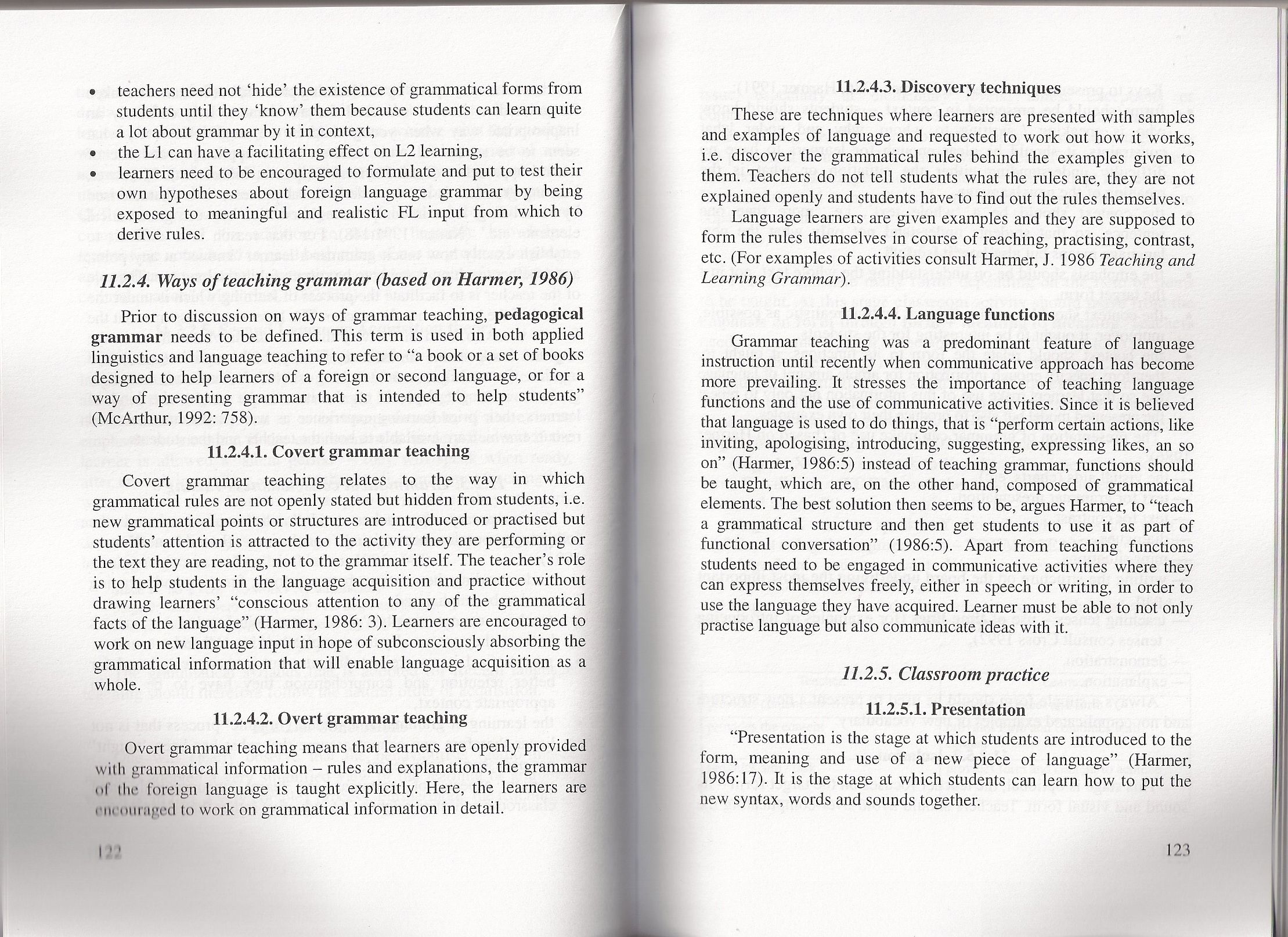59160 skanowanie0061 (7)

• teachers need not ‘hide’ the existence of grammatical forms from students until they ‘know’ them because students can leam quite a lot about grammar by it in context,
• the LI can have a facilitating effect on L2 leaming,
• leamers need to be encouraged to formulate and put to test their own hypotheses about foreign language grammar by being exposed to meaningful and realistic FL input from which to derive rules.
11.2.4. Ways of teaching grammar (based on Harmer, 1986)
Prior to discussion on ways of grammar teaching, pedagogical grammar needs to be defined. This term is used in both applied linguistics and language teaching to refer to “a book or a set of books designed to help leamers of a foreign or second language, or for a way of presenting grammar that is intended to help students” (McArthur, 1992: 758).
11.2.4.1. Covert grammar teaching
Covert grammar teaching relates to the way in which grammatical rules are not openly stated but hidden from students, i.e. new grammatical points or structures are introduced or practised but students’ attention is attracted to the activity they are performing or the text they are reading, not to the grammar itself. The teacher’s role is to help students in the language acąuisition and practice without drawing learners’ “conscious attention to any of the grammatical facts of the language” (Harmer, 1986: 3). Learners are encouraged to work on new language input in hope of subconsciously absorbing the grammatical information that will enable language acąuisition as a whole.
11.2.4.2. Overt grammar teaching
Overt grammar teaching means that leamers are openly provided willi grammatical information - rules and explanations, the grammar] of the foreign language is taught explicitly. Here, the leamers are •ncouraged lo work on grammatical information in detail.
11.2.4.3. Discovery techniąues
These are techniąues where leamers are presented with samples and examples of language and reąuested to work out how it works, i.e. discover the grammatical rules behind the examples given to them. Teachers do not tell students what the rules are, they are not explained openly and students have to find out the rules themselves.
Language leamers are given examples and they are supposed to form the rules themselves in course of reaching, practising, contrast, etc. (For examples of activities consult Harmer, J. 1986 Teaching and Leaming Grammar).
11.2.4.4. Language functions
Grammar teaching was a predominant feature of language instruction until recently when communicative approach has become morę prevailing. It stresses the importance of teaching language functions and the use of communicative activities. Since it is believed that language is used to do things, that is “perform certain actions, like inviting, apologising, introducing, suggesting, expressing likes, an so on” (Harmer, 1986:5) instead of teaching grammar, functions should be taught, which are, on the other hand, composed of grammatical elements. The best solution then seems to be, argues Harmer, to “teach a grammatical structure and then get students to use it as part of functional conversation” (1986:5). Apart from teaching functions students need to be engaged in communicative activities where they can express themselves freely, either in speech or writing, in order to use the language they have acąuired. Leamer must be able to not only practise language but also communicate ideas with it.
11.2.5. Classroom practice 11.2.5.1. Presentation
“Presentation is the stage at which students are introduced to the form, meaning and use of a new piece of language” (Harmer, 1986:17). It is the stage at which students can learn how to put the new syntax, words and sounds together.
123
I
Wyszukiwarka
Podobne podstrony:
skanowanie0061 (7) • teachers need not ‘hide’ the existence of grammatical forms f
World War I Cemeteries Need Not Perish The group of 400 wartime cemeteries in Western Gali-cia undou
DIAGNOSIS II: POLYCENTRIC GLOBALISATION World society is coming about not under the Icadcrship of in
ERROR: The path /users/xxyyzz/Downloads/Cheatsheet.xlsx is invalid because it is not in the list of
Dysorvequation method (which 1$ used in quantum field theory) have been analyzed (107). The existenc
offered by it. Many schools of statically conservative thought do not conceal the role of social com
5 Rewrite the sentences. Use the words in Capital letters. Do not change the meaning of the
CHAPTER II 17 86230 the econoay by public spending, whlch has not at the beglnnlng of a period a cor
rozrodczy cz 1 Od •&Reproduction The process of producing a new generation to continue the exist
więcej podobnych podstron